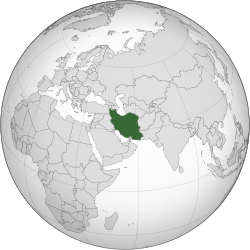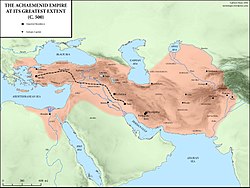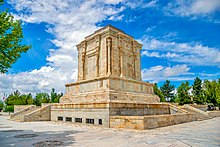
A | B | C | D | E | F | G | H | CH | I | J | K | L | M | N | O | P | Q | R | S | T | U | V | W | X | Y | Z | 0 | 1 | 2 | 3 | 4 | 5 | 6 | 7 | 8 | 9
This article may be too long to read and navigate comfortably. When this tag was added, its readable prose size was 15,600 words. (January 2024) |
Islamic Republic of Iran | |
|---|---|
| Motto: استقلال، آزادی، جمهوری اسلامی Esteqlâl, Âzâdi, Jomhuri-ye Eslâmi "Independence, freedom, the Islamic Republic" (de facto)[1] | |
| Anthem: سرود ملی جمهوری اسلامی ایران Sorud-e Melli-ye Jomhuri-ye Eslâmi-ye Irân "National Anthem of the Islamic Republic of Iran" | |
| Capital and largest city | Tehran 35°41′N 51°25′E / 35.683°N 51.417°E |
| Official languages | Persian |
| Recognised regional languages | |
| Ethnic groups (2003 estimate)[5] | |
| Demonym(s) | Iranian |
| Government | Unitary presidential theocratic Islamic republic |
| Ali Khamenei | |
| Ebrahim Raisi | |
| Mohammad Mokhber | |
| Mohammad Bagher Ghalibaf | |
| Gholam-Hossein Mohseni-Eje'i | |
| Ahmad Jannati | |
| Legislature | Islamic Consultative Assembly |
| Establishment history | |
| c. 3200 BC | |
| c. 678 BC | |
| 550 BC | |
| 247 BC | |
| 224 AD | |
| 819 | |
| 934 | |
| 1501 | |
| 1736 | |
| 1751 | |
| 1796 | |
| 15 December 1925 | |
| 11 February 1979 | |
| 3 December 1979 | |
| 28 July 1989 | |
| Area | |
• Total | 1,648,195 km2 (636,372 sq mi) (17th) |
• Water (%) | 1.63 (as of 2015)[6] |
| Population | |
• 2024 estimate | |
• Density | 55/km2 (142.4/sq mi) (132nd) |
| GDP (PPP) | 2023 estimate |
• Total | $1.753 trillion[8] |
| GDP (nominal) | 2023 estimate |
• Total | $403.5 billion[8] |
| Gini (2019) | 40.9[9] medium |
| HDI (2022) | high (78th) |
| Currency | Iranian rial (ریال) (IRR) |
| Time zone | UTC+3:30 (IRST) |
| Date format | yyyy/mm/dd (SH) |
| Driving side | right |
| Calling code | +98 |
| ISO 3166 code | IR |
| Internet TLD | |
Iran,[a] also known as Persia[b] and officially the Islamic Republic of Iran (IRI),[c] is a country in West Asia. It is bordered by Iraq to the west and Turkey to the northwest, Azerbaijan, Armenia, the Caspian Sea and Turkmenistan to the north, Afghanistan to the east, Pakistan to the southeast, the Gulf of Oman & the Persian Gulf to the south. With almost 90 million people in an area of 1.648 million square kilometres (0.64 million square miles), Iran ranks 17th in the world in both geographic size and population. The country is divided into five regions with 31 provinces. The nation's capital and most populous city is Tehran, with around 16 million people in its metropolitan area, other major urban centres include Mashhad, Isfahan, Karaj, and Shiraz.
Iran is one of the world's oldest civilizations, beginning with the Elamites in the fourth millennium BC. It was first unified by the Medes in the seventh century BC and reached its territorial height in the sixth century BC, when Cyrus the Great founded the Achaemenid Empire, one of the largest empires in antiquity. Alexander the Great conquered the empire in the fourth century BC, and it was subsequently divided into several Hellenistic states. An Iranian rebellion established the Parthian Empire in the third century BC, which was succeeded in the third century AD by the Sasanian Empire. Arab Muslims conquered the region in the seventh century AD, leading to its Islamization. Iran became a major centre of Islamic culture and learning, and its culture, language, and customs spread across the Muslim world. A series of native Iranian Muslim dynasties ruled the country until the Seljuk and the Mongol conquests of the 11th to 14th centuries. In the 16th century, the native Safavids re-established a unified Iranian state with Twelver Shia Islam as the official religion, marking the beginning of modern Iranian history.
Under Nader Shah Afshar in the 18th century, Iran was a leading world power, though by the 19th century, it had lost significant territory through a series of conflicts with the Russian Empire. The early 20th century saw the Persian Constitutional Revolution, the establishment of the Pahlavi dynasty, and efforts at modernization. Attempts to nationalise the country's vast fossil fuel supply led to an Anglo-American coup in 1953. After the Iranian Revolution, the monarchy was overthrown in 1979 and the Islamic Republic of Iran was established by Ruhollah Khomeini, who became the country's first supreme leader. Iran is officially governed as an Islamic Republic with a presidential system, albeit with ultimate authority vested in a theocratic supreme leader (rahbar), currently Ali Khamenei since Khomeini's death in 1989. The Iranian government is authoritarian and has attracted widespread criticism for its constraints and violations of human rights.
Iran is a major emerging, middle and regional power, due to its large reserves of fossil fuels, including the world's second largest natural gas supply, third largest proven oil reserves, its strategic location in the Asian continent, its military capabilities, its regional influence, and its role as the world's focal point of Shia Islam. It is a founding member of the United Nations, the ECO, the OIC, the OPEC, the G77, the SCO, and a member of BRICS.[12] Owing it to its long history and rich cultural legacy, Iran is home to 27 UNESCO World Heritage Sites, the 10th highest number in the world, and ranks 5th globally in the number of inscriptions of Intangible Cultural Heritage, or human treasures.[13][14] The people of Iran are multicultural and comprise a wide variety of ethnic, linguistic, and religious groups.
Etymology
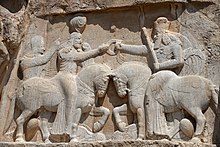
The term Iran ("the land of the Aryans") derives from Middle Persian Ērān, first attested in a third-century inscription at Naqsh-e Rostam, with the accompanying Parthian inscription using Aryān, in reference to the Iranians.[16] The terms Ērān and Aryān are oblique plural forms of gentilic nouns ēr- (Middle Persian) and ary- (Parthian), both deriving from Proto-Iranian language *arya- (meaning "Aryan", i.e. "of the Iranians"),[16][17] recognised as a derivative of Proto-Indo-European language *ar-yo-, meaning "one who assembles (skilfully)".[18] According to Iranian mythology, the name comes from Iraj, a legendary king.[19]
Historically, Iran has been referred to as "Persia" by the West,[20][21] due mainly to the writings of Greek historians who referred to all of Iran as "Persís" (Ancient Greek: Περσίς),[22] meaning "the land of the Persians".[23] "Persia" is the Fars province in southwest Iran, also known as "Pârs".[24] The Persian word "Fârs" (فارس), derived from the earlier form "Pârs" (پارس), which is in turn derived from Pârsâ (Old Persian: 𐎱𐎠𐎼𐎿). Due to the province's historical importance,[25][26] the term "Persia" originated from this region by the Greeks in around 550 BC,[27] and Westerners started to refer the entire country as "Persia",[28][29] until 1935, when Reza Pahlavi requested the international community to refer to the country by its native and original name, Iran.[30][31] While the Iranians had been calling their nation Iran since at least 1000 BC, this name change was only made so that the Western World would begin to refer to the country by the same name as its people.[24] Today, both Iran and Persia are used in cultural contexts, while Iran remains mandatory in official state contexts.[32][33][34][35][36][37]
The Persian pronunciation of Iran is [ʔiːˈɾɒːn]. Common Commonwealth English pronunciations of Iran are listed in the Oxford English Dictionary as /ɪˈrɑːn/ and /ɪˈræn/,[38] while American English dictionaries such as Merriam-Webster's provide pronunciations which map to /ɪˈrɑːn, -ˈræn, aɪˈræn/,[39] or likewise in Random House Webster's Unabridged Dictionary as /ɪˈræn, ɪˈrɑːn, aɪˈræn/. The Cambridge Dictionary lists /ɪˈrɑːn/ as the British pronunciation and /ɪˈræn/ as the American pronunciation. The pronunciation guide from Voice of America also provides /ɪˈrɑːn/.[40] The American English pronunciation /aɪˈræn/ may be heard in U.S. media.
History
This section may contain an excessive amount of intricate detail that may interest only a particular audience. (January 2024) |
Prehistory

The earliest attested archaeological artifacts in Iran confirm human presence since the Lower Palaeolithic.[42] Iran's Neanderthal artifacts have been found mainly in the Zagros region, at sites such as Warwasi and Yafteh.[43][44][45] From the tenth to the seventh millennium BC, early agricultural communities began to flourish in and around the Zagros region, including Chogha Golan,[46][47] Chogha Bonut,[48][49] and Chogha Mish.[50][51][52][53] The occupation of grouped hamlets in the area of Susa ranges from 4395 to 3490 BC.[54] There are dozens of prehistoric sites across the Iranian Plateau, pointing to the existence of ancient cultures and urban settlements in the fourth millennium BC.[53][55][56]
During the Bronze Age, the territory was home to several civilizations,[57][58] including Elam, Jiroft, and Zayanderud. Elam, the most prominent of these, developed in the southwest alongside those in Mesopotamia, and continued its existence until the emergence of the Iranian empires. The advent of writing in Elam was parallelled to Sumer; the Elamite cuneiform developed beginning in the third millennium BC.[59] Diverse artifacts from The Bronze Age, huge structures from the Iron Age and various sites dating back to the Sassanid, Parthian and Islamic eras indicated suitable conditions for human civilization over the past 8,000 years in Piranshahr.[60][61]
From the 34th to the 20th century BC, northwestern Iran was part of the Kura-Araxes culture, which stretched into the neighbouring Caucasus and Anatolia. Since the earliest second millennium BC, Assyrians settled in swaths of western Iran and incorporated the region into their territories.
Ancient Iran
By the second millennium BC, the ancient Iranian peoples arrived in Iran from the Eurasian Steppe,[62] rivalling the native settlers of the region.[63][64] As the Iranians dispersed into the wider area of Greater Iran and beyond, the boundaries of modern Iran were dominated by Median, Persian, and Parthian tribes. The Ancient Iranian history began with the Elamites in the fourth millennium BC, in the far west and southwest of Iran, stretching from the lowlands of Khuzestan and Ilam Province. In the Old Elamite period (Middle Bronze Age), Elam consisted of kingdoms on the Iranian plateau, centered in Anshan, and from the mid-2nd millennium BC, it was centered in Susa in the Khuzestan lowlands. Elam was part of the early urbanization of the Near East during the Chalcolithic period. From the late tenth to the late seventh century BC, the Iranian peoples, together with the pre-Iranian kingdoms, fell under the domination of the Assyrian Empire, based in northern Mesopotamia.[65][66] Under king Cyaxares, the Medes and Persians entered into an alliance with Babylonian ruler Nabopolassar, as well as the fellow Iranian Scythians and Cimmerians, and together they attacked the Assyrian Empire. Civil war ravaged the Assyrian Empire between 616 and 605 BC, freeing their respective peoples from three centuries of Assyrian rule.[65]

The unification of the Median tribes under king Deioces in 728 BC led to the foundation of the Median Empire and their capital Ecbatana, unifying Iran as a nation for the first time in 625 BC.[67] By 612 BC, the Medes Empire controlled almost the entire territory of present-day Iran and eastern Anatolia.[68] This marked the end of the Kingdom of Urartu, which was subsequently conquered and dissolved.[69][70]
In 550 BC, Cyrus the Great took over the Median Empire, and founded the Achaemenid Empire by unifying other city-states. The conquest of Media was a result of what is called the Persian Revolt. Later conquests under Cyrus and his successors expanded the empire to include Lydia, Babylon, Egypt, parts of the Balkans and Eastern Europe, as well as lands to the west of the Indus and Oxus rivers. In 539 BC Persian forces defeated the Babylonian army at Opis, marking the end of around four centuries of Mesopotamian domination of the region by conquering the Neo-Babylonian Empire.[71][72]
In 518 BC, Persepolis was founded by Darius the Great as the ceremonial capital of the Achaemenid Empire which, at its greatest extent, was the largest empire the world had yet seen,[72] and at its peak it ruled over 44% of the world's population.[73] The Achaemenid Empire is noted for the release of the Jewish exiles in Babylon,[74] building infrastructures such as the Royal Road and the Chapar (postal service), and the use of an official language, Imperial Aramaic.[72] In 334 BC, Alexander the Great defeated the last Achaemenid emperor, Darius III, at the Battle of Issus. Following the premature death of Alexander, Iran fell under the control of the Hellenistic Seleucid Empire.
In the middle of the second century BC, the Parthian Empire rose to become the main power in Iran, and the century-long geopolitical arch-rivalry between the Romans and the Parthians began, culminating in the Roman–Parthian Wars. The Parthian Empire continued as a feudal monarchy for nearly five centuries, until 224 CE, when it was succeeded by the Sasanian Empire.[75] They and their neighbouring arch-rival, the Roman-Byzantines, were the world's two dominant powers for over four centuries.[76][77]
The Sasanians established an empire within the frontiers achieved by the Achaemenids, with their capital at Ctesiphon. Late antiquity is considered one of Iran's most influential periods, as under the Sasanians,[78] their influence reached ancient Rome (and through that as far as Western Europe),[79][80] Africa,[81] China, and India,[82] and played a prominent role in the formation of the mediaeval art of both Europe and Asia.[76][77]
Mediaeval period and Iranian Intermezzo
The prolonged Byzantine–Sasanian wars, most importantly the climactic war of 602–628, as well as the social conflict within the Sasanian Empire, opened the way for an Arab invasion in the seventh century.[83][84] The empire was initially defeated by the Rashidun Caliphate, which was succeeded by the Umayyad Caliphate, followed by the Abbasid Caliphate. A proloynged and gradual process of state-imposed Islamization followed, which targeted Iran's then Zoroastrian majority and included religious persecution,[85][86][87] demolition of libraries[88] and fire temples,[89] a special tax penalty ("jizya"),[90][91] and language shift.[92][93]
In 750, the Abbasids overthrew the Umayyads.[94] Arabs Muslims and Persians of all strata made up the rebel army, which was united by the converted Persian Muslim, Abu Muslim.[95][96][97] In their struggle for power, society gradually became cosmopolitan. Persians and Turks began to replace Arabs in most fields. A hierarchy of officials emerged, a bureaucracy at first Persian and later Turkish which decreased Abbasid prestige and power for good.[98]
After two centuries of Arab rule, various native semi-independent and independent Iranian dynasties in the Iranian Plateau rose, namely the Tahirids, Saffarids, Sajids, Samanids, Ziyarids, Buyids, Sallarids, Rawadids, Marwanids, Shaddadids, Kakuyids, Annazids and Hasanwayhids, appearing on the fringes of the declining Abbasid Caliphate.[99] The period, known as the Iranian Intermezzo, was an interlude between the decline of Abbasid rule and power by Arabs and the "Sunni Revival" with the 11th-century emergence of the Seljuks. It consisted Iranian support based on Iranian territory, and most significantly a revived Iranian national spirit and culture in an Islamic form. It also revived the Persian language, with the most significant Persian-language literature from this period being Shahnameh by Ferdowsi, the country's national epic.[100][101][102][103]
The blossoming literature, philosophy, mathematics, medicine, astronomy and art became major elements in a new age for Iranian civilization, during a period known as the Islamic Golden Age.[104][105] The Islamic Golden Age reached its peak by the 10th and 11th centuries, during which Iran was the main theatre of scientific activities.[106] The tenth century saw a mass migration of Turkic tribes from Central Asia into the Iranian Plateau.[107] Turkic tribesmen were first used in the Abbasid army as mamluks (slave-warriors).[95] As a result, the Mamluks gained significant political power. In 999, large portions of Iran came briefly under the rule of the Ghaznavids, and longer subsequently under the Seljuk and Khwarezmian empires.[107] The Seljuks subsequently gave rise to the Sultanate of Rum in Anatolia.[108][109] The result of the adoption and patronage of Persian culture by Turkish rulers was the development of a distinct Turco-Persian tradition.
From 1219 to 1221, under the Khwarazmian Empire, Iran suffered a devastating invasion by the Mongol Empire. According to Steven R. Ward, "Mongol violence and depredations killed up to three-fourths of the population of the Iranian Plateau, possibly 10 to 15 million people. Some historians have estimated that Iran's population did not again reach its pre-Mongol levels until the mid-20th century."[110] Most modern historians either outright dismiss or are highly skeptical of such statistics and deem them to be exaggerations by Muslim chroniclers of that era. Indeed, as far as the Iranian plateau was concerned, the bulk of the Mongol onslaught and battles were in the northeast Iran, such as in the cities of Nishapur and Tus.[111][112][113]
Following the fracture of the Mongol Empire in 1256, Hulagu Khan established the Ilkhanate Empire in Iran. In 1357, the capital Tabriz was occupied by the Golden Horde khan Jani Beg and the centralised power collapsed, resulting in the emergence of rivalling dynasties. In 1370, yet another conqueror, Timur, took control over Iran, establishing the Timurid Empire. In 1387, Timur ordered the complete massacre of Isfahan, killing 70,000 citizens.[114]
Early modern period
Safavids
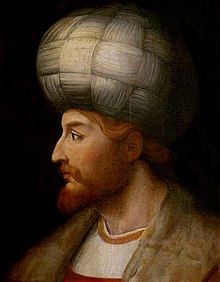
By the 1500s, Ismail I established the Safavid Empire,[115][116] with his capital at Tabriz.[107] Beginning with Azerbaijan, he extended his authority over the Iranian territories, and established an intermittent Iranian hegemony over large parts of Greater Iran.[117] Iran was predominantly Sunni,[118] but Ismail instigated a forced conversion to the Shia branch, marking one of the most important turning points in the history of Islam, and the beginning of modern Iranian history.[119][120][116][121][122] As a result, Iran is the only official Shia nation today, with it holding an absolute majority in Iran and the Republic of Azerbaijan.[123][124]
The relationship between the Safavids and the West begins with the presence of the Portuguese in the Persian Gulf from the 16th century, oscillating between alliances and open war between the 17th and 18th century. The Safavid era saw the start of mass integration from Caucasian populations and their mass resettlement within the heartlands of Iran. In 1588, Abbas the Great came to the throne during a troubled period. Under his leadership, Iran developed the ghilman system where thousands of Circassian, Georgian, and Armenian slave-soldiers joined the civil administration and the military. With the help of these newly created layers in Iranian society, Abbas eclipsed the power of the Qizilbash in the civil administration, the royal house, and the military. Abbas was a great builder and moved his capital from Qazvin to Isfahan, making the city the pinnacle of Safavid architecture. Tabriz was returned to Iran after 18 years of Ottoman rule. In his later years, following a court intrigue involving several leading Circassians, Abbas became suspicious of his own sons and had them killed or blinded. Following a gradual decline in the late 1600s and the early 1700s, which was caused by internal conflicts, the continuous wars with the Ottomans, and the foreign interference (most notably Russian), the Safavid rule was ended by the Pashtun rebels who besieged Isfahan and defeated Soltan Hoseyn in 1722.
Afsharids
Zdroj:https://en.wikipedia.org?pojem=IranText je dostupný za podmienok Creative Commons Attribution/Share-Alike License 3.0 Unported; prípadne za ďalších podmienok. Podrobnejšie informácie nájdete na stránke Podmienky použitia.
Antropológia
Aplikované vedy
Bibliometria
Dejiny vedy
Encyklopédie
Filozofia vedy
Forenzné vedy
Humanitné vedy
Knižničná veda
Kryogenika
Kryptológia
Kulturológia
Literárna veda
Medzidisciplinárne oblasti
Metódy kvantitatívnej analýzy
Metavedy
Metodika
Text je dostupný za podmienok Creative
Commons Attribution/Share-Alike License 3.0 Unported; prípadne za ďalších
podmienok.
Podrobnejšie informácie nájdete na stránke Podmienky
použitia.
www.astronomia.sk | www.biologia.sk | www.botanika.sk | www.dejiny.sk | www.economy.sk | www.elektrotechnika.sk | www.estetika.sk | www.farmakologia.sk | www.filozofia.sk | Fyzika | www.futurologia.sk | www.genetika.sk | www.chemia.sk | www.lingvistika.sk | www.politologia.sk | www.psychologia.sk | www.sexuologia.sk | www.sociologia.sk | www.veda.sk I www.zoologia.sk



